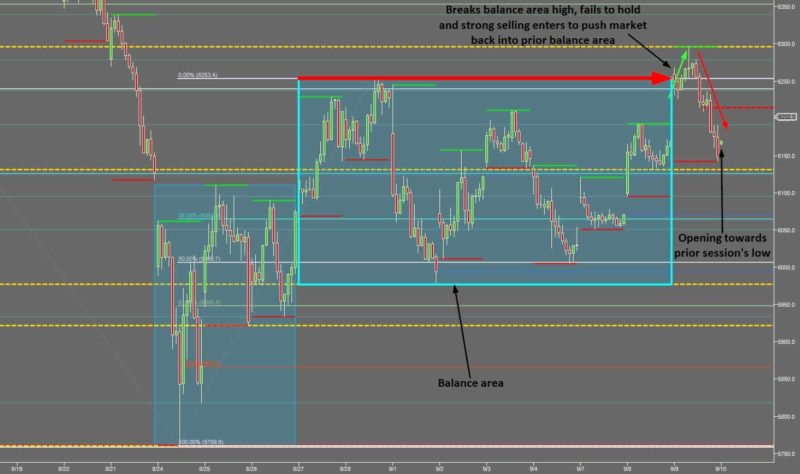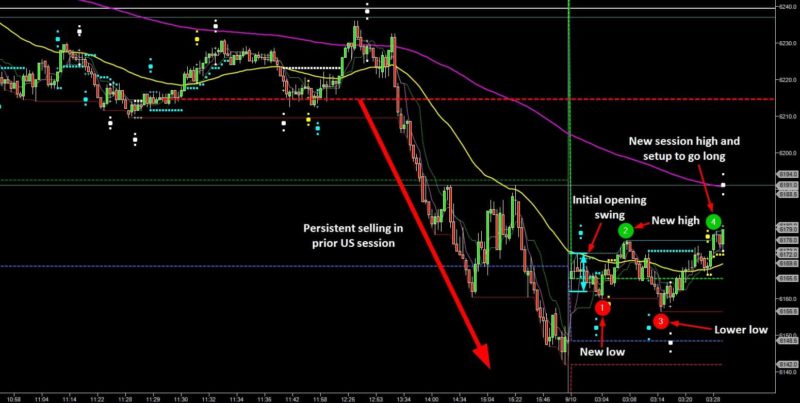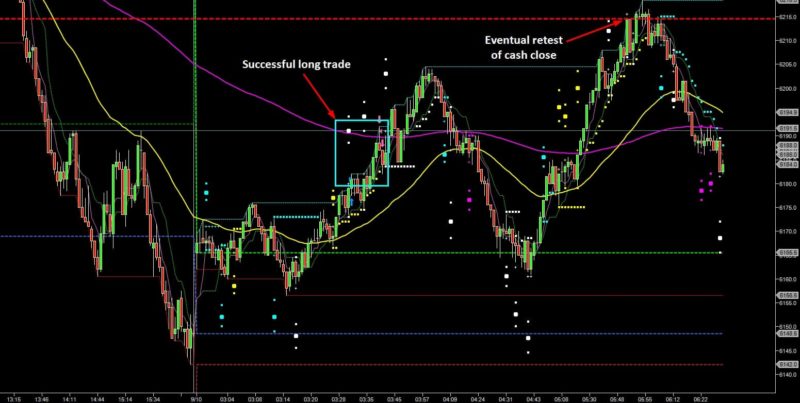- September 12, 2015
- Posted by: Shane Daly
- Categories: Advanced Trading Strategies, Day Trading, trading psychology

One of the aspects that’s at the very heart of what I try to show traders is that they need to assess context in order to find success. Context is something which many find elusive. However, it need not be.
Simply trying to recognize whether the market is balanced or trending and where the critical price levels are can be enough to tip the trading odds in your favor. But on its own context isn’t quite enough and this is because the markets don’t have to do what you expect them to, when you expect them to do it.
So it’s vital that after you’ve identified the context, you have a range of scenarios and are adaptable to market activity as the auction unfolds.
Failure to Break Away
When a market is balanced and breaks out only to fail and revert back to its recent range, there’s strong context to suggest further movement back in the direction opposite to the breakout.
This can be attributed to the fact that the push beyond the balance extreme has failed to find sufficient additional activity to break away from the balance so traders looking for a reversal can take some confidence from this observation and additionally, the fact that anyone playing the breakout will be feeling the heat and if they’re short-term traders, they’ll need to exit as the market reverses.
Take the FTSE futures as an example.

In this example, the market breached the high of the right hand balance area only to fall back inside it on persistent selling.
The market then opened up near the low and within the prior balance area.
This gives me a strong indication that the market could look lower within this balance area as it has demonstrated by its own action that it’s not ready to find value higher than recent trading activity.
Markets are like buses, not planes
Once you’ve spotted some key contextual information like in the example above, you’re well ahead of many other traders. But in most cases it’s not enough information in isolation to decide on how you want to trade.
Simply saying “well I think I’m going to only be looking to go short now” is in fact a dangerous game to play in itself.
Clearly it’s possible for markets to move at times, virtually in one direction with few pullbacks. But in reality this is rarely what happens.
Markets tend to move far more like buses than planes.
- Buses stop in a range of locations checking for passengers and are rarely the quickest in getting to where they are going.
- Planes tend to fly in a relatively direct path.
The point is that even if you’re confident of the overall market direction, you can’t be totally sure of how it will get there.
Multiple Theories
With this in mind, it’s important to come up with several theories of how the market could behave. Remember, it really doesn’t matter which theory plays out although there may be a higher probability of one scenario playing out over another.
Often when a market tells you it’s not interested in doing one thing, it’s a fantastic cue to tell you it might be about to do another.
Let’s look at the FTSE example again.

In this example, the market had already given a big clue that it wanted to remain in balance and possibly sell off some more. It sold off direction ally during the US session to end the session looking pretty bearish for the next day.
However, this was after the EU cash close. So there was a higher chance that it’d want to check higher at least to see if sellers were going to step in before looking lower.
If you felt confident that the market would continue the sell-off the following session, your primary idea might be that it would look to test a reasonable amount higher before turning its attentions towards extending past the prior session’s low.
Again, it doesn’t matter whether you’re ‘right’ or not about this, just having the idea and seeing what the market does do is the key aspect here.
A second idea might be that the market sells off straight from open.
A third could be that after an initial attempt to trade lower, buyers step in and push the market up.
Invalidation of an Idea can be Illuminating
If it the market does something different to what it looks like it will probably do, that’s valuable information that can lead to great trading opportunities if you’re alive to it.
In the case of the FTSE, an initial opening swing gave rise to two tests lower, with each test being followed by a higher high. Probably not the kind of behavior of a strongly bearish market.

So when a setup to go long after the market had had several failed attempts to go with what might have been viewed initially as the obvious direction (i.e. a continuation lower), I was perfectly happy to take the trade with a view to the cash session gap being closed.

Be Adaptable to Market Activity
If you take a view on the market then it’s a good start.
But being inflexible when the market moves in the opposite direction, can at best leave you left behind and at worst leave you with a losing trade. If you have a very stubborn Chimp mind, it can also lead to a blood bath after fighting the market’s true direction.
What it boils down to is this: a market’s overall feeling can change on a huge number of variables throughout the day. What the market looks like it wants to do to begin with can be flipped on its head later on in a session and although it’s important to track some key influencing factors, you can’t possibly hope to be fully appraised of every piece of new information throughout the day.
And let’s face it, we can all be just plain wrong at times too.
So have an idea of what you think you’ll see in the market but please, be adaptable to market activity as the auction unfolds.
Options trading has become very popular over the last few years. Netpicks own “Options Guru” Mike has put together a hot list of some of the best names to trade in the Options market. You can click here and download your free hotlist to see what names Mike has been piling up the winners with.
